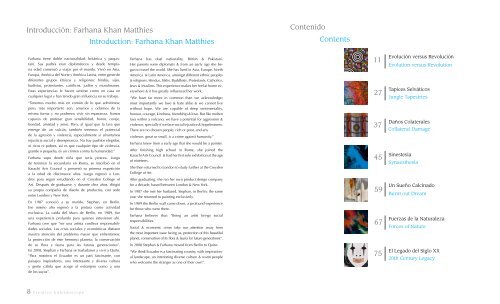Catálogo Farhana Khan Matthies - Centro Cultural PUCE
Catálogo Farhana Khan Matthies - Centro Cultural PUCE
Catálogo Farhana Khan Matthies - Centro Cultural PUCE
Create successful ePaper yourself
Turn your PDF publications into a flip-book with our unique Google optimized e-Paper software.
Introducción: <strong>Farhana</strong> <strong>Khan</strong> <strong>Matthies</strong><br />
<strong>Farhana</strong> tiene doble nacionalidad: británica y paquistaní.<br />
Sus padres eran diplomáticos y desde temprana<br />
edad comenzó a viajar por el mundo. Vivió en Asia,<br />
Europa, América del Norte y América Latina, entre gente de<br />
diferentes grupos étnicos y religiones: hindús, sijes,<br />
budistas, protestantes, católicos, judíos y musulmanes.<br />
Estas experiencias le hacen sentirse como en casa en<br />
cualquier lugar y han tenido gran influencia en su trabajo.<br />
“Tenemos mucho más en común de lo que admitimos;<br />
pero, más importante aún, amamos y odiamos de la<br />
misma forma y no podemos vivir sin esperanza. Somos<br />
capaces de profesar gran sensibilidad, honor, coraje,<br />
bondad, amistad y amor. Pero, al igual que la lava que<br />
emerge de un volcán, también tenemos el potencial<br />
de la agresión y violencia, especialmente si afrontamos<br />
injusticia social y desesperanza. No hay pueblos elegidos,<br />
ni ricos ni pobres, así es que cualquier tipo de violencia,<br />
grande o pequeña, es un crimen contra la humanidad.”<br />
<strong>Farhana</strong> supo desde niña que sería pintora. Luego<br />
de terminar la secundaria en Roma, se inscribió en el<br />
Karachi Arts Council y presentó su primera exposición<br />
a la edad de diecinueve años. Luego regresó a Londres<br />
para seguir estudiando en el Croyden College of<br />
Art. Después de graduarse, y durante diez años, dirigió<br />
su propia compañía de diseño de productos, con sede<br />
entre Londres y New York.<br />
En 1987 conoció a su marido, Stephan, en Berlín.<br />
Ese mismo año regresó a la pintura como actividad<br />
exclusiva. La caída del Muro de Berlín, en 1989, fue<br />
una experiencia profunda para quienes estuvieron ahí.<br />
<strong>Farhana</strong> cree que “ser una artista conlleva responsabilidades<br />
sociales. Las crisis sociales y económicas distraen<br />
nuestra atención del problema mayor que enfrentamos:<br />
la protección de este hermoso planeta; la conservación<br />
de su flora y fauna para las futuras generaciones”.<br />
En 2008, Stephan y <strong>Farhana</strong> se trasladaron a vivir a Quito.<br />
“Para nosotros el Ecuador es un país fascinante, con<br />
paisajes inspiradores, una interesante y diversa cultura<br />
y gente cálida que acoge al extranjero como a uno<br />
de los suyos”.<br />
8 C r e a t i v e K a l e i d o s c o p e<br />
Introduction: <strong>Farhana</strong> <strong>Khan</strong> <strong>Matthies</strong><br />
<strong>Farhana</strong> has dual nationality, British & Pakistani.<br />
Her parents were diplomats & from an early age she began<br />
to travel the world. She has lived in Asia, Europe, North<br />
America & Latin America, amongst different ethnic peoples<br />
& religions. Hindus, Sikhs, Buddhists, Protestants, Catholics,<br />
Jews & Muslims. This experience makes her feel at home everywhere<br />
& it has greatly influenced her work.<br />
“We have far more in common than we acknowledge;<br />
most importantly we love & hate alike & we cannot live<br />
without hope. We are capable of deep sentimentality,<br />
honour, courage, kindness, friendship & love. But like molten<br />
lava within a volcano, we have a potential for aggression &<br />
violence, specially if we face social injustice & hopelessness.<br />
There are no chosen people, rich or poor, and any<br />
violence, great or small, is a crime against humanity.”<br />
<strong>Farhana</strong> knew from a early age that she would be a painter.<br />
After finishing high school in Rome, she joined the<br />
Karachi Arts Council & had her first solo exhibition at the age<br />
of nineteen.<br />
She then returned to London to study further at the Croyden<br />
College of Art.<br />
After graduating, she ran her own product design company<br />
for a decade, based between London & New York.<br />
In 1987 she met her husband, Stephan, in Berlin; the same<br />
year she returned to painting exclusively.<br />
In 1989 the Berlin wall came down, a profound experience<br />
for those who were there.<br />
<strong>Farhana</strong> believes that: “Being an artist brings social<br />
responsibilities.<br />
Social & economic crises take our attention away from<br />
the most important issue facing us, protection of this beautiful<br />
planet, conservation of its flora & fauna for future generations”.<br />
In 2008 Stephan & <strong>Farhana</strong> moved from Berlin to Quito:<br />
“We think Ecuador is a fascinating country, with inspirational<br />
landscape, an interesting diverse culture & warm people<br />
who welcome the stranger as one of their own”.<br />
Contenido<br />
Contents<br />
11<br />
27<br />
37<br />
45<br />
59<br />
67<br />
75<br />
Evolución versus Revolución<br />
Evolution versus Revolution<br />
Tapices Selváticos<br />
Jungle Tapestries<br />
Daños Colaterales<br />
Collateral Damage<br />
Sinestesia<br />
Synaesthesia<br />
Un Sueño Calcinado<br />
Burnt out Dream<br />
Fuerzas de la Naturaleza<br />
Forces of Nature<br />
El Legado del Siglo XX<br />
20th Century Legacy


